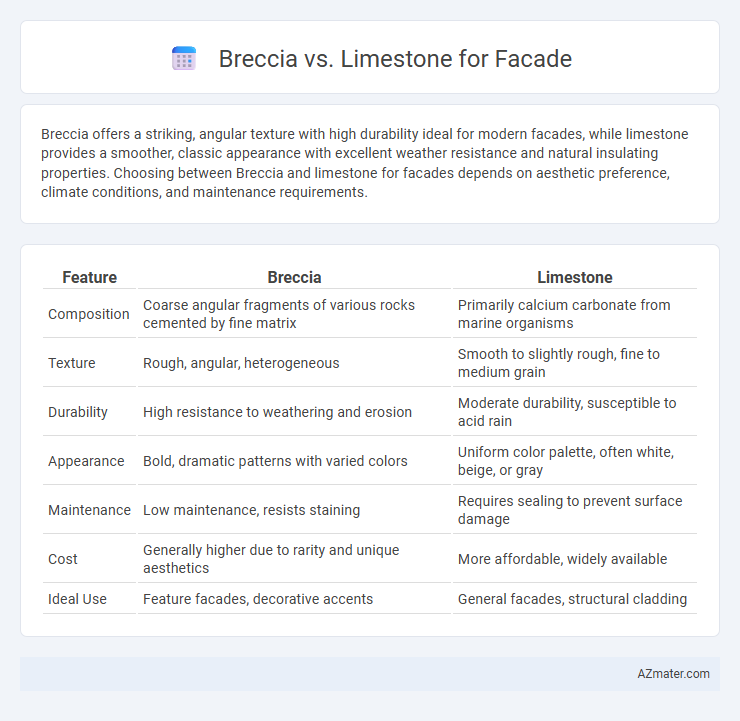Breccia offers a striking, angular texture with high durability ideal for modern facades, while limestone provides a smoother, classic appearance with excellent weather resistance and natural insulating properties. Choosing between Breccia and limestone for facades depends on aesthetic preference, climate conditions, and maintenance requirements.
Table of Comparison
| Feature | Breccia | Limestone |
|---|---|---|
| Composition | Coarse angular fragments of various rocks cemented by fine matrix | Primarily calcium carbonate from marine organisms |
| Texture | Rough, angular, heterogeneous | Smooth to slightly rough, fine to medium grain |
| Durability | High resistance to weathering and erosion | Moderate durability, susceptible to acid rain |
| Appearance | Bold, dramatic patterns with varied colors | Uniform color palette, often white, beige, or gray |
| Maintenance | Low maintenance, resists staining | Requires sealing to prevent surface damage |
| Cost | Generally higher due to rarity and unique aesthetics | More affordable, widely available |
| Ideal Use | Feature facades, decorative accents | General facades, structural cladding |
Understanding Breccia and Limestone: An Overview
Breccia is a sedimentary rock composed of angular fragments cemented together, known for its striking, irregular patterns and durability ideal for unique facade designs. Limestone, primarily composed of calcium carbonate, offers a smooth texture and classic aesthetic with excellent weather resistance and ease of carving, making it a popular choice for traditional building facades. Understanding the mineral composition, texture, and durability differences between Breccia and Limestone influences facade selection based on architectural style and environmental exposure.
Geological Formation of Breccia vs Limestone
Breccia forms from the cementation of angular, broken rock fragments typically resulting from mechanical weathering or tectonic processes, creating a coarse and heterogeneous texture. Limestone predominantly originates from the accumulation and compaction of marine organisms' calcium carbonate shells, leading to a more uniform, fine-grained sedimentary rock. The distinct geological formations result in Breccia's rugged, angular facade appearance versus Limestone's smoother, more homogeneous surface texture ideal for architectural cladding.
Aesthetic Differences in Facade Applications
Breccia features irregular, angular fragments that create a dynamic and textured facade appearance, making it ideal for bold, rustic, or natural designs. Limestone offers a smoother, more uniform surface with subtle color variations, lending itself to elegant, timeless, and classical facade applications. The choice between breccia and limestone significantly impacts the visual character and architectural style of exterior cladding.
Durability and Weather Resistance Comparison
Breccia offers superior durability compared to limestone, thanks to its dense composition and natural cementation of angular fragments, making it highly resistant to cracking and erosion. Limestone, while aesthetically appealing with its uniform texture, is more porous and susceptible to weathering effects such as acid rain and freeze-thaw cycles, which can degrade its surface over time. For facade applications exposed to harsh weather conditions, breccia provides enhanced weather resistance and longevity, reducing maintenance needs and preserving architectural integrity.
Maintenance Requirements for Breccia and Limestone Facades
Breccia facades require regular sealing and cleaning to prevent staining and maintain their vibrant color due to their porous nature, while limestone facades demand periodic water repellent treatments to protect against erosion and discoloration caused by weathering. Both materials benefit from gentle, non-abrasive cleaning methods to avoid surface damage, but limestone is generally more susceptible to acid rain and environmental pollutants, increasing its maintenance frequency. Proper maintenance schedules for breccia and limestone facades are crucial to preserving their structural integrity and aesthetic appeal over time.
Cost Analysis: Breccia vs Limestone
Breccia generally has a higher cost than limestone due to its unique composition and limited quarry sources, making it a premium choice for facades. Limestone tends to be more affordable and widely available, resulting in lower overall material and installation expenses. When budgeting for facade projects, selecting limestone offers cost-efficiency without compromising aesthetic versatility, whereas breccia demands a higher investment for its distinctive and dramatic appearance.
Installation Techniques and Challenges
Breccia requires precise cutting and careful handling during facade installation due to its heterogeneous composition of angular fragments, which can cause uneven surfaces and potential breakage. Limestone, being softer and more uniform, allows for easier cutting and more straightforward mounting but demands protection against weathering and acidic damage over time. Both materials necessitate skilled labor and appropriate anchoring systems to ensure stability and durability on building exteriors.
Sustainability and Environmental Impact
Breccia, composed of angular fragments cemented together, offers higher durability and lower porosity compared to limestone, reducing maintenance needs and extending facade lifespan. Limestone extraction and processing often result in greater carbon emissions due to quarrying depth and energy-intensive cutting, whereas breccia's local sourcing potential can minimize transportation impact. Both materials benefit from natural thermal insulation properties, but breccia's structural robustness contributes to long-term sustainability by limiting facade replacements and associated environmental costs.
Best Use Cases for Breccia and Limestone Facades
Breccia, with its dynamic, multi-colored fragments and high durability, is best suited for striking, decorative facades that require a bold visual impact and resistance to weathering, particularly in contemporary commercial or luxury residential buildings. Limestone offers a more uniform, classic appearance with excellent workability, making it ideal for historic restorations, traditional architecture, and projects seeking a timeless, elegant facade with moderate durability. Both materials provide natural stone advantages, but breccia excels in statement-making applications while limestone suits refined, heritage-inspired designs.
Choosing the Right Stone for Your Facade
Breccia offers a unique, striking appearance with its angular fragments and varied colors, making it ideal for facades that demand a bold statement and textured depth. Limestone provides a classic, uniform look with excellent durability and weather resistance, perfect for timeless, elegant facades in both historic and modern architecture. When choosing the right stone for your facade, consider the aesthetic impact, local climate conditions, and maintenance requirements to ensure long-lasting beauty and structural integrity.

Infographic: Breccia vs Limestone for Facade
 azmater.com
azmater.com